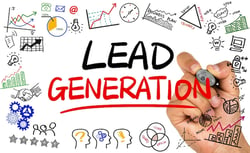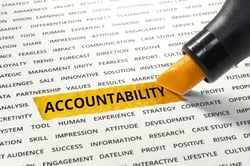Tl;dr - Want to understand how mismatched most industrial sales teams are for today's buyers? Sit the leadership of a B2B sales team down around the conference table and ask them to define a lead. Just one simple question. Guaranteed, they'll fail to agree, much less articulate the buying journey and how they support it. If we're going to market and sell successfully we need precise definitions and common terms across our teams.
"We Just Need More Sales Leads"
I've heard that many times during conversations with industrial manufacturers about generating industrial sales leads and digital marketing.
It's normally followed by something like "We just need to get to the table. When we're sitting at the table we win more than our fair share." (And few can then tell me what their close rates are, or what percentage of leads become qualified projects.)
And that's the precise point at which many digital marketing initiatives start to go sideways.
Why?
Because industrial sales teams are ill prepared to sell the leads that are generated. It's not just about generating industrial sales leads - sales and marketing teams have to have a sales process in addition to the lead generation process.
Not All Leads are Created Equally
 A trade show lead is different from a referral, which is as different from an old trade journal "bingo card" lead as it is from new PPC lead.
A trade show lead is different from a referral, which is as different from an old trade journal "bingo card" lead as it is from new PPC lead.
That's obvious.
And within those categories, there is a broad spectrum of leads. Tradeshows, for example, often generate a range of "leads" from casual conversations with start-ups that have general future interest but no specific current requirements, to late-stage fully-spec'd projects with allocated funding.
That's also obvious.
Nevertheless, most manufacturing marketing teams hand them all over as generic "leads" to an industrial sales team that refers to them monolithically as "leads." Then, truth be told, the sales team normally scans them to determine which they think merit follow-up.
They may then have a process to flag some portion as "qualified leads" although that designation is rarely defined either.
Does it mean they have a budget approved and a timeline? If that's the definition, isn't it actually closer to an opportunity/project precursor (using an outdated BANT model) than a "lead"?
Or does it mean that it's a contact and company that actually buys, or could reasonably buy, what you sell? Isn't that a prospect?
The point is that our Lead Lexicon is lacking.
An Outmoded B2B Lead Generation Model
Before we solve for vocabulary, though, we have to back up and understand how we arrived here.
Sales carried the bulk of the revenue generation responsibility. They prospected and replied to telephone inquiries. They met people at trade shows. They pursued referrals and followed loyal customers as they changed companies. As they had time, they also followed up on the bulk leads that marketing generated.
Marketing's job was to organize trade shows, burnish the brand with print ads in trade journals, and try to create some leads with direct response approaches.
Everything ran through the sales team. Buyers relied on sales for access to information. That created an opportunity for sales people to interact with buyers. Average sales people used that opportunity to pitch, and see if they evoked a response of interest. Strong sales people simultaneously educated and investigated, using the interaction to create opportunities for further discussion around how a purchase might help a business.
The sales team was responsible for lead follow-up, lead management, lead qualification, lead nurturing, account development, contact management, project creation, project management, deal creation and relationship management.
Some did it well. Many poorly. Scale was generally achieved with more sales people on the street.
Two things have changed. It's hard to know for sure whether one caused the other or if they were merely coincidental. It doesn't matter. It's today's dynamic.
First, buyers became largely self-sufficient thanks to the internet. They've also become increasingly time-stressed and unable or unwilling to entertain conversations without clear potential value.
Second, pseudo-scientific management came to sales. Scientific because when management saw performance deteriorate as buyers retreated, they started to push sales to limit discussions and activities to only those buyers with characteristics indicating imminent purchase. Pseudo because, despite the exhortations, they normally don't track numerous performance details to manage and coach.
And right there - between phantom buyers and sales people being told to only talk to those who are ready to buy - we blew up business development, lead generation, and lead management.
We Need to Meet Buyers Where They Are
The solution is simple, but hard.
We need to meet buyers where they are in their journey, and we need to disassociate our traditional model (and all its vestigial staffing, organizational, ego, and hierarchical implications) from our revenue growth approach.
That requires two key steps.
 First, we need to construct a revenue growth continuum that positions the right resource (marketing or sales, passive or active, outbound or inbound, text or video or meeting) for the right person at the right time - all the time. (That's the principle behind the Overall Revenue Effectiveness™ (ORE™) framework.)
First, we need to construct a revenue growth continuum that positions the right resource (marketing or sales, passive or active, outbound or inbound, text or video or meeting) for the right person at the right time - all the time. (That's the principle behind the Overall Revenue Effectiveness™ (ORE™) framework.)
Second, to support that, we must develop a clear language and philosophy around contacts, prospects and leads that's common to our sales team, marketing teams and management. This language is important because it will frame how we think about and work with buyers (our language impacts our mindset and behaviors.) It also helps us engineer our revenue growth system.
Buyers (and different members of the buying team) have different needs (those of which they are aware, and those of which they aren't - after all, many of our buyers rarely buy what we sell and therefore benefit from process help) that clearly defined and properly used language help clarify. That in turn helps us optimize topics and tactics for any point in the buying journey.
Important Definitions
 First, a quick caveat. You'll find some industrial inbound marketing firms that will use fairly generic terms (IQL - information qualified lead, MQL - marketing qualified lead, SQL - sales qualified lead) without really considering the buying journey and nuanced situations. And, shockingly, you'll find many that just talk about leads.
First, a quick caveat. You'll find some industrial inbound marketing firms that will use fairly generic terms (IQL - information qualified lead, MQL - marketing qualified lead, SQL - sales qualified lead) without really considering the buying journey and nuanced situations. And, shockingly, you'll find many that just talk about leads.
Like many aspects of really refined and optimized ORE, think of this as a continuum along a maturity model. What you'll find below may be more than you need to start, but will shape your thinking and understanding.
Below are some basic terms that need to be defined, and common circumstances that need to be named - along with a suggestion for a name.
- a person in your database (could be vendor, journalist, prospect, competitor, employee, customer, etc.) - contact
- types of contacts by buying role including terms that match your sales process (e.g. financial buyer, decision maker, "mobilizer", blocker, maintenance, procurement, etc.) - buying role
- types of contacts by their relationship to your company (e.g. prospect, vendor, competitor, journalist, employee, customer) - contact type
- a person who visits your site - visitor
- a person who visits >5 pages on your website, over 2 or more occasions, but doesn't "convert" - anonymous lead
- a company from which 2 or more people fit #5 above - anonymous company lead
- a person who "converts" on an offer - fills out a form for an informational offer that's very high level (not indicative of purchase intent) | a former champion that's moved to a new prospect company - lead
- a person who "converts" on a meeting or more substantial offer (e.g. vendor comparison matrix, guide to preparing a project specification) - prospect
- a company from which you have a #8 and where sales contact has been successfully established - prospect company
- a company that matches your Ideal Customer Profile (ICP )and/or meets certain intent data criteria - data qualified company
- a person who you understand through discussion to have a problem which you can solve, responsibility for the consequences of (not) doing so, and organizational authority to ascertain the value of doing so - qualified prospect
- a company that matches the ICP and has been flagged as a target for proactive sales or account-based marketing - target company
- an acknowledged and defined requirement that you can solve and a qualified prospect has agreed needs to be solved - project
- a project when a critical mass of buying roles are engaged, you know why they'll buy and the risks to them for failing to do so, while they'll select you and how money will be approved - qualified project
- the process by which contacts and companies can be automatically advanced or reduced in qualification by observations of behavior - lead scoring
- a measure of a company's likelihood to eventually become a customer based on a constellation of factors including number of engaged contacts, magnitude of problem to solve, fit against ICP, etc. - propensity to buy
No set of definitions will consider every possibility. Nor should it - this can definitely be over-complicated. The goal is to harmonize understandings so that as we begin to execute tactically, we'll know how to do so. Examples of other situations to consider.
- a current customer company (in another location, or even the same one) with a new qualified prospect (e.g. plant manager or corporate engineer) is a qualified prospect
- qualified prospect who works for a company that isn't data qualified (in other words they're unlikely to actually buy despite the person's insight, intent, and energy)
- a company that pushes a project off for a future fiscal cycle
- prospects who consistently reconverts every few months but never become qualified
- contacts who never engage with periodic emails
- qualified projects that don't close
- lead from a data qualified company
- variability contingent on buyer persona
- adaptation based on buying process
Defining Lead Metrics Too
While we're working on definitions, we need them for tracking our success in converting leads. Will more leads generate more revenue? Who knows.
Rather than focus just on how to generate industrial sales leads we should also know:
- cost/lead by lead source
- conversion rates (to meetings with key decision makers, qualified opportunities and sales $)
And we should be able to compare these metrics by lead source.
Circling Back - Why is This Important?
 These clear definitions are important in two ways. First, to avoid costly mistakes. Second, to power an effective revenue growth program.
These clear definitions are important in two ways. First, to avoid costly mistakes. Second, to power an effective revenue growth program.
Let's start with the costly mistakes. Those companies that say "we need more leads" get them. Great content served through a digital footprint that's built around ease of conversion and great customer experience will generate lots of leads. Many will be people doing research, often even before they've even considered any sort of investment. Yet sales people who are told to qualify quickly and focus on short paths to revenue will, in their rush to "qualify", fulfill every negative stereotype that buyers have.
Great sales people would guide a conversation, provide additional resources, and provide insights that will move that lead quickly to qualified even if that wasn't their early intention. But average sales people will drive them away, then return to the office moaning about the low quality of the leads marketing provides.
The digital lead-generation program will appear to fail. At the very least it will be challenging to measure the effectiveness and attribute specific transaction and lifetime revenue to specific marketing investments.
So setting expectations and leveling up the sales team (using proper sales force testing tools) are important for any modicum of success.
More importantly, though, an effective revenue growth framework is built around the decisions that these clear definitions enable. For instance:
- what level of contact qualification merits direct sales contact? what level of sales contact (e.g. BDR? field sales? CEO?)
- what level of company qualification merits proactive outreach to other project sales roles? what data infrastructure is required to inform that?
- when are projects included in a forecast? with what confidence?
- what content is required for lead generation and sales enablement to move contacts and companies through a journey?
- what bright line clarifies when you should walk away from a project to avoid squandering resources?
- in what situation should contacts from target companies be shown tactical paid ads?
- which lead sources, activities and investments merit increased (or decreased) investment based on the likelihood to result in qualified prospects, qualified projects, or revenue?
- what is the cost/qualified prospect? cost of customer acquisition? lifetime value?
- how do marketing and sales collaborate to identify and advance contacts, companies and projects?
- for which type of activity, by which level/type of contact, company and project, should which sales/customer success person be dynamically notified? how should those activities impact lead scoring?
- what chat bot experiences are appropriate for each contact for effective conversational marketing and sales?
- how many attempts, using what channels, is your minimum expectation for a lead? how much effort should go into identifying an anonymous lead? what ongoing investment should be made in leads that can't be contacted? how can you increase the lead-connection rate?
- how can you improve your propensity to buy modeling to focus sales efforts where it will have the biggest return?
- what's an appropriate org/staffing model for marketing, inside, and outside sales?
So, yes, we can help you increase leads. And you may have enough other pieces in place for that to make a difference.
No, you don't have to solve for everything initially. You can get started without refining all these answers.
BUT, don't forget, you face the same challenge. No doubt your team sometimes struggles with possible buyers who don't know what they don't know and hope to have a fast and easy answer to how your capital equipment can solve very complex and nuanced production challenges they have. You have to strike a balance between collecting the information you need to answer correctly vs. not overwhelming them. You also feel a strong obligation to provide the right answer.
We're in the same position.
There's Value in the Process as well as the Definitions
 For all the reasons outlined above, it's important to arrive at precise definitions and use them in your internal revenue growth language and reporting. The output - that common lexicon - undergirds every aspect of a revenue growth framework.
For all the reasons outlined above, it's important to arrive at precise definitions and use them in your internal revenue growth language and reporting. The output - that common lexicon - undergirds every aspect of a revenue growth framework.
The process is really important too. It's frustrating, time-consuming work. And companies have to do the work. It's never successful to just impose a set of definitions because the hard discussions are skipped and there's no common buy-in.
It's a classic sausage making exercise that will illuminate many areas of poor alignment and misunderstanding between leadership, management, and contributors, just as between inside and outside, and marketing and sales.
It will also force you to ask questions that haven't been asked before, much less answered. For instance, what are the roles of manufacturing marketing and industrial sales in a world where buyers operate in the shadows? How do we improve sales rep effectiveness? What predictive KPIs should we be measuring in addition to the common retrospective ones?
Any detailed inbound marketing strategy for B2B industrials or capital equipment companies that doesn't resolve these definitions early will be inherently defective.
And you thought it was a simple task......


